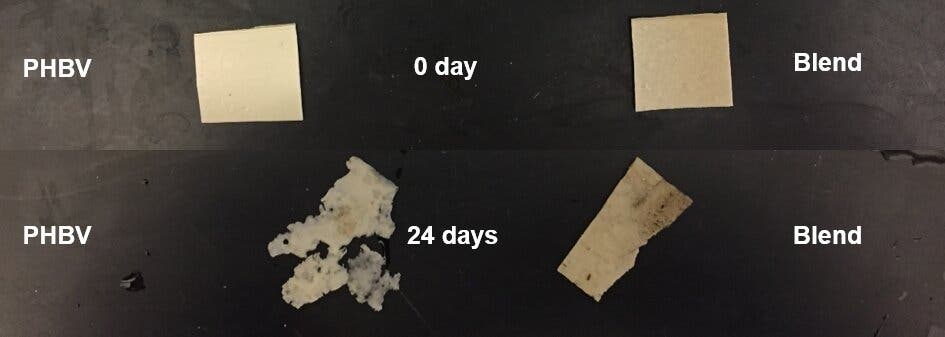Researchers at The Ohio State University may have developed a viable alternative to plastic — one that breaks down naturally.

The new bioplastic and rubber blend devised by Ohio State researchers proved much more durable than the bioplastic on its own
Image credits The Ohio State University.
To say that humanity has a plastic problem would be an understatement. Plastic waste litters the oceans, steadily builds up in landfills, and it’s not going away (by itself). Needless to say, the search for a viable, biodegradable replacement for plastic is quite a heated one.
New research from The Ohio State University may have come up with one such material. The team combined natural rubber with bioplastics to create a novel material that could be everything we, and the food industry, needs.
Bendy and strong
“Previous attempts at this combination were unsuccessful because the softness of the rubber meant the product lost a lot of strength in the process,” said lead author Xiaoying Zhao, a postdoctoral researcher in Ohio State’s Department of Food Science and Technology.
About 90% of today’s plastics are petroleum-based and not biodegradable, which is a major environmental concern. So far, attempts to make viable plastic replacements from renewable sources haven’t been very successful — mostly due to processing and economic constraints. Among the obstacles, products to date have been too brittle for food packaging.
The team’s product, derived from microbial fermentation and strengthened with natural rubber, would perform largely like conventional plastic, and, according to the team, it is probably the greatest success in this area so far.
So, how did they do it? Well, the team started by melting rubber together with a plant-based thermoplastic called PHBV, organic peroxide, and another additive called trimethylolpropane triacrylate (TMPTA). The resulting material was 75% tougher and 100% more flexible than PHBV on its own. These two properties combined make it much better suited for food packaging, a massive contributor to plastic waste.
The extra strength and flexibility are a huge improvement, as previous attempts to combine rubber and PHBV resulted in materials that were too weak to be used in food packaging — they couldn’t withstand any step, be it processing, shipping, or handling in stores and homes. It was especially a problem for containers used for freezing and then microwaving, said the study’s senior author, Yael Vodovotz, a professor of food science and technology at Ohio State.
Other attempts at making this type of rubber-enhanced bioplastic have reduced the strength of the PHBV by as much as 80%, Zhao adds. The team’s approach only reduced the material’s strength by 30%, which is still manageable. However, what the team needed was to get their material more flexible than previous attempts without a significant reduction in strength, as flexibility is very important for plastic films used to package everything from fresh produce to frozen foods, she said.
“Imagine trying to pull a block of concrete apart with your hands. That’s testing its strength. But karate chopping it with your hand or foot is testing its toughness—how easily it breaks,” explains study co-author Katrina Cornish, an expert in natural rubber and professor of horticulture and crop science at Ohio State.
“You can never pull [the new material] apart, but if you’re strong enough you can break it.”
The team wants to continue researching which other biodegradable and environmentally-conscious materials might be used as fillers to further strengthen their composite material. Some of the things being considered are tomato skins, eggshells, and the “cake” left behind after a fellow researcher extracts oil from spent coffee grounds. They’re even considering the use of invasive grasses in their material, which would help solve another environmental issue at the same time.
“We want something that would otherwise go to waste that is sustainable and also relatively cheap,” said the study’s senior author, Yael Vodovotz, a professor of food science and technology at Ohio State. “We could dry them, grind them up and potentially use these grasses as a fibrous filler,” Vodovotz said.
Beyond packaged foods, a bioplastic could potentially be used in other food-related applications such as utensils and cutting boards or gloves for those working in food service. It could also see use as a building material, or to make parts for cars and airplanes.
“As we get closer and closer to working with food manufacturers, there are specific questions our potential partners are asking,” Vodovotz said. “We have to be very careful about what we use in this process in order to meet their needs, and they have very specific parameters.”
The paper “Synergistic Mechanisms Underlie the Peroxide and Coagent Improvement of Natural-Rubber-Toughened Poly(3-hydroxybutyrate-co-3-hydroxyvalerate) Mechanical Performance” has been published in the journal Polymers.









